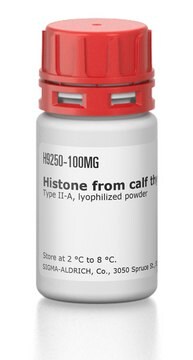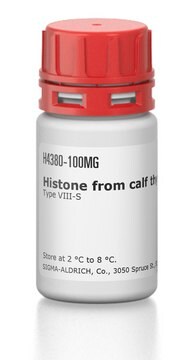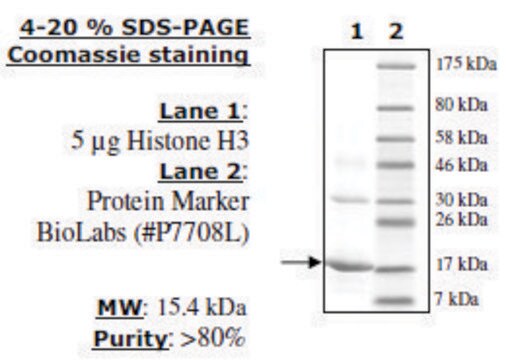About This Item
Polecane produkty
pochodzenie biologiczne
bovine (calf) thymus
Poziom jakości
typ
Type III-S
Postać
powder
stężenie
≥60% protein (biuret)
metody
activity assay: suitable
rozpuszczalność
H2O: soluble 10 mg/mL, clear to hazy, colorless to light yellow
temp. przechowywania
2-8°C
Szukasz podobnych produktów? Odwiedź Przewodnik dotyczący porównywania produktów
Zastosowanie
- as a positive control in the in vitro kinase assay to examine the ability of Cdc2-cyclin B1 to phosphorylate GST-CD-4 protein
- in Cdk5 activity assay
- in histone H1 kinase assay
- as a Poly(ADP-ribose) (PAR) acceptor in the assessment of in vitro PAR polymerase activity
- as an acceptor of 32P from [γ-32P]ATP in order to measure protein kinase activity of lysate from small and large luteal cells
Działania biochem./fizjol.
Cechy i korzyści
Inne uwagi
Uwaga dotycząca przygotowania
Kod klasy składowania
11 - Combustible Solids
Klasa zagrożenia wodnego (WGK)
WGK 3
Temperatura zapłonu (°F)
Not applicable
Temperatura zapłonu (°C)
Not applicable
Środki ochrony indywidualnej
Eyeshields, Gloves, type N95 (US)
Certyfikaty analizy (CoA)
Poszukaj Certyfikaty analizy (CoA), wpisując numer partii/serii produktów. Numery serii i partii można znaleźć na etykiecie produktu po słowach „seria” lub „partia”.
Masz już ten produkt?
Dokumenty związane z niedawno zakupionymi produktami zostały zamieszczone w Bibliotece dokumentów.
Klienci oglądali również te produkty
Nasz zespół naukowców ma doświadczenie we wszystkich obszarach badań, w tym w naukach przyrodniczych, materiałoznawstwie, syntezie chemicznej, chromatografii, analityce i wielu innych dziedzinach.
Skontaktuj się z zespołem ds. pomocy technicznej







